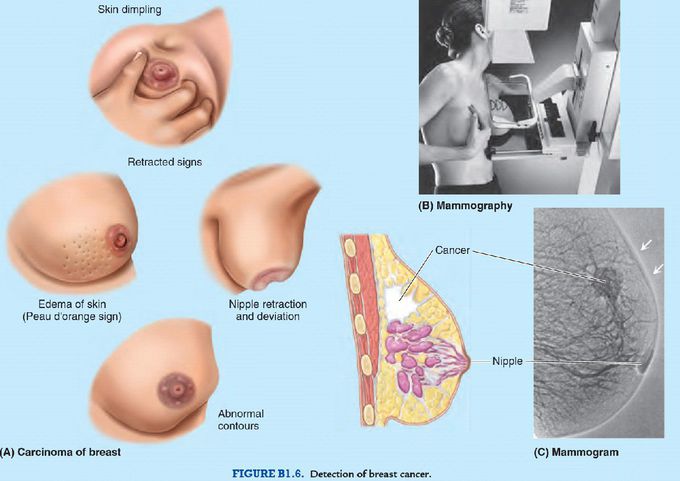

Carcinoma Of Breast
Understanding the lymphatic drainage of the breasts is of practical importance in predicting the metastases (dispersal) of cancer cells from a carcisize, especially in multiparous women—those who have given birth to two or more children. Consequently, because of variations in size and shape, the nipples are not a reliable guide to the 4th intercostal spaces in adult females. noma of the breast (breast cancer). Carcinomas of the breast are malignant tumors, usually adenocarcinomas (glandular cancer) arising from the epithelial cells of the lactiferous ducts in the mammary gland lobules . Metastatic cancer cells that enter a lymphatic vessel usually pass through two or three groups of lymph nodes before entering the venous system. Interference with the lymphatic drainage by cancer may cause lymphedema (edema, excess fl uid in the subcutaneous tissue), which in turn may result in deviation of the nipple and a thickened, leather-like appearance of the skin. Prominent “puffy” skin between dimpled pores give it an orange-peel appearance (peau d’orange sign). Larger dimples (fi ngertip size or bigger) result from cancerous invasion of the glandular tissue and fi brosis (fi brous degeneration), which causes shortening or places traction on the suspensory ligaments. Subareolar breast cancer may cause retraction of the nipple by a similar mechanism involving the lactiferous ducts. Breast cancer typically spreads by means of lymphatic vessels (lymphogenic metastasis), which carry cancer cells from the breast to the lymph nodes, chiefl y those in the axilla. The cells lodge in the nodes, producing nests of tumor cells (metastases). Abundant communications among lymphatic pathways and among axillary, cervical, and parasternal nodes may also cause metastases from the breast to develop in the supra clavicular lymph nodes, the opposite breast, or the abdomen . Because most of lymphatic drainage of the breast is to the axillary lymph nodes, they are the most common site of metastasis from a breast cancer. Enlargement of these palpable nodes suggests the possibility of breast cancer and may be key to early detection. However, the absence of enlarged axillary lymph nodes is no guarantee that metastasis from a breast cancer has not occurred; the malignant cells may have passed to other nodes, such as the infraclavicular and supraclavicular lymph nodes.

